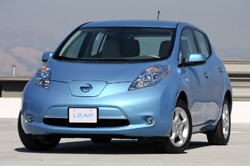Watts Your Mileage?
Expect to hear the words, "range anxiety," a lot in the months to come, what with the Nissan Leaf, Chevrolet Volt and an assortment of other battery-electric vehicles and plug-in hybrids ready to hit the market.
The first generation of battery cars, like Leaf, will likely deliver an average of only about 100 miles on a charge – not much more than the range at which the typical motorist starts to look for a gas station in a conventional automobile.
Actually, that figure is only a rough approximation, as I learned recently while getting ready for my first drive of the 2011 Leaf. Under ideal conditions, I was advised, Nissan engineers have traveled as many as 140 miles. But on a cold and dreary day, creeping along in traffic with the heater on full, the little battery car might barely clock 70 miles before its batteries are fully discharged. (Similarly, General Motors now cautions that Volt will typically get somewhere between 25 and 50 miles, rather than the oft-quoted 40 on battery power.)
Sure, driving conditions and driver habits have always had a big impact on mileage. Slam the throttle at every light and you might get less than half the fuel economy your new Ford Mustang will deliver on the highway. But while that may cut into your budget, the only other downside is having to fuel up more often.
Paul A. Eisenstein is Publisher of TheDetroitBureau.com, and a 30-year veteran of the automotive beat. His editorials bring his unique perspective and deep understanding of the auto world to Autoblog readers on a regular basis.
With a battery car, not knowing your actual energy efficiency – and especially your range – could leave you sitting on the side of the road or knocking on doors hoping to find someone kind enough to let you plug in for a few hours.
So, there's a fairly significant debate underway over what and how to tell consumers about their new electric vehicles. The feds have even proposed a letter-grade system that would reward highly energy-efficient vehicles, though an "A" grade wouldn't guarantee you'd be able to make it to work and back on a bad day.
But what does an MPGe actually mean to a consumer? Not much – especially if you don't consider the additional energy that might have gone into producing the alternative fuel. That's a notable complaint about ethanol, for example.
What about miles-per-kilowatt-hour? That's probably the closest we can come to the classic American fuel economy standard, or MPG, and would make it easy to compare the efficiency of different battery cars.
You can easily do this comparison now, by the way. If you know the Leaf gets 100 miles, on average, and has a 24 kilowatt-hour lithium-ion battery pack, that works out to four-mile/kWh. Or does it? Actually, no, it doesn't.
 To maximize the life of their batteries, manufacturers like Nissan are only using a portion of the energy that a lithium-ion battery is capable of storing, typically somewhere between 50 and 65 percent. In other words, they might allow you to charge the battery pack to somewhere between 80 and 90 percent of capacity then shut the vehicle down when you've dropped below 25 or 30 percent. That's how they're going to ensure they can deliver on those eight-year/100,000 battery warranties.
To maximize the life of their batteries, manufacturers like Nissan are only using a portion of the energy that a lithium-ion battery is capable of storing, typically somewhere between 50 and 65 percent. In other words, they might allow you to charge the battery pack to somewhere between 80 and 90 percent of capacity then shut the vehicle down when you've dropped below 25 or 30 percent. That's how they're going to ensure they can deliver on those eight-year/100,000 battery warranties.
Unfortunately, the makers aren't giving out the precise numbers. That's a competitive secret and the best we can do is guess. If a vehicle has 24 kWh of batteries, uses only 12 (50 percent of capacity) and gets 100 miles per charge, it's actually yielding 8 kWh. But does that matter when you're about to hit the Big E?
Sure, we'd like to be able to compare the efficiency of two BEVs, but for day-to-day driving, what we hope federal regulators will come up with is a grid that shows how each battery car will perform under a handful of real-world conditions. Think of it as the city/highway ratings on steroids.
Before we got into the Leaf, we were shown four distinct examples of the range we might expect. Like a conventional hybrid, battery cars actually do better in medium-speed stop-and-go driving, where they can regenerate energy normally lost during braking and handling. That's the city/highway model. But you also need to consider factors that matter little in a conventional car, like whether you're using your lights and climate control system.
Surprisingly, electric air conditioning is reasonably efficient, but you'll blow through your battery in a hurry staying warm and keeping the windshield clear during a Michigan snowstorm. And that's where something like a four-quadrant grid on a battery car's Monroney (window) sticker may be the best way to tell a potential buyer what they can really expect day-to-day.
Knowing what you're in for is the best way to reduce your range anxiety.
Paul A. Eisenstein is Publisher of TheDetroitBureau.com, and a 30-year veteran of the automotive beat. His editorials bring his unique perspective and deep understanding of the auto world to Autoblog readers on a regular basis.
Expect to hear the words, "range anxiety," a lot in the months to come, what with the Nissan Leaf, Chevrolet Volt and an assortment of other battery-electric vehicles and plug-in hybrids ready to hit the market.
The first generation of battery cars, like Leaf, will likely deliver an average of only about 100 miles on a charge – not much more than the range at which the typical motorist starts to look for a gas station in a conventional automobile.
Actually, that figure is only a rough approximation, as I learned recently while getting ready for my first drive of the 2011 Leaf. Under ideal conditions, I was advised, Nissan engineers have traveled as many as 140 miles. But on a cold and dreary day, creeping along in traffic with the heater on full, the little battery car might barely clock 70 miles before its batteries are fully discharged. (Similarly, General Motors now cautions that Volt will typically get somewhere between 25 and 50 miles, rather than the oft-quoted 40 on battery power.)
Sure, driving conditions and driver habits have always had a big impact on mileage. Slam the throttle at every light and you might get less than half the fuel economy your new Ford Mustang will deliver on the highway. But while that may cut into your budget, the only other downside is having to fuel up more often.
Paul A. Eisenstein is Publisher of TheDetroitBureau.com, and a 30-year veteran of the automotive beat. His editorials bring his unique perspective and deep understanding of the auto world to Autoblog readers on a regular basis.
With a battery car, not knowing your actual energy efficiency – and especially your range – could leave you sitting on the side of the road or knocking on doors hoping to find someone kind enough to let you plug in for a few hours.
So, there's a fairly significant debate underway over what and how to tell consumers about their new electric vehicles. The feds have even proposed a letter-grade system that would reward highly energy-efficient vehicles, though an "A" grade wouldn't guarantee you'd be able to make it to work and back on a bad day.
With a battery car, not knowing your actual energy efficiency – and especially your range – could leave you sitting on the side of the road.
As part of the recently-concluded Auto X-Prize – which I referred to in my last column for Autoblog – entries were judged according to their MPGe, or Mile Per Gallon equivalent. It's an attempt to make technologies fit into an old model, and like a square peg in a round hole, it doesn't work very well. The idea is to measure distance traveled per energy unit consumed. You can do this with some basic math formulas that measure such things as kilowatt-hours or BTUs (or British Thermal Units, the way you measure, for example, the heat output of a furnace).
But what does an MPGe actually mean to a consumer? Not much – especially if you don't consider the additional energy that might have gone into producing the alternative fuel. That's a notable complaint about ethanol, for example.
What about miles-per-kilowatt-hour? That's probably the closest we can come to the classic American fuel economy standard, or MPG, and would make it easy to compare the efficiency of different battery cars.
You can easily do this comparison now, by the way. If you know the Leaf gets 100 miles, on average, and has a 24 kilowatt-hour lithium-ion battery pack, that works out to four-mile/kWh. Or does it? Actually, no, it doesn't.
 To maximize the life of their batteries, manufacturers like Nissan are only using a portion of the energy that a lithium-ion battery is capable of storing, typically somewhere between 50 and 65 percent. In other words, they might allow you to charge the battery pack to somewhere between 80 and 90 percent of capacity then shut the vehicle down when you've dropped below 25 or 30 percent. That's how they're going to ensure they can deliver on those eight-year/100,000 battery warranties.
To maximize the life of their batteries, manufacturers like Nissan are only using a portion of the energy that a lithium-ion battery is capable of storing, typically somewhere between 50 and 65 percent. In other words, they might allow you to charge the battery pack to somewhere between 80 and 90 percent of capacity then shut the vehicle down when you've dropped below 25 or 30 percent. That's how they're going to ensure they can deliver on those eight-year/100,000 battery warranties.
Unfortunately, the makers aren't giving out the precise numbers. That's a competitive secret and the best we can do is guess. If a vehicle has 24 kWh of batteries, uses only 12 (50 percent of capacity) and gets 100 miles per charge, it's actually yielding 8 kWh. But does that matter when you're about to hit the Big E?
Sure, we'd like to be able to compare the efficiency of two BEVs, but for day-to-day driving, what we hope federal regulators will come up with is a grid that shows how each battery car will perform under a handful of real-world conditions. Think of it as the city/highway ratings on steroids.
Before we got into the Leaf, we were shown four distinct examples of the range we might expect. Like a conventional hybrid, battery cars actually do better in medium-speed stop-and-go driving, where they can regenerate energy normally lost during braking and handling. That's the city/highway model. But you also need to consider factors that matter little in a conventional car, like whether you're using your lights and climate control system.
Surprisingly, electric air conditioning is reasonably efficient, but you'll blow through your battery in a hurry staying warm and keeping the windshield clear during a Michigan snowstorm. And that's where something like a four-quadrant grid on a battery car's Monroney (window) sticker may be the best way to tell a potential buyer what they can really expect day-to-day.
Knowing what you're in for is the best way to reduce your range anxiety.
Paul A. Eisenstein is Publisher of TheDetroitBureau.com, and a 30-year veteran of the automotive beat. His editorials bring his unique perspective and deep understanding of the auto world to Autoblog readers on a regular basis.


Sign in to post
Please sign in to leave a comment.
Continue